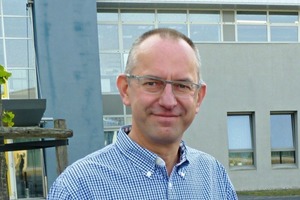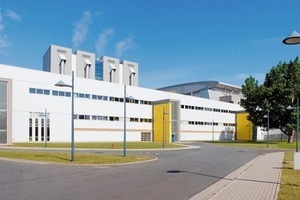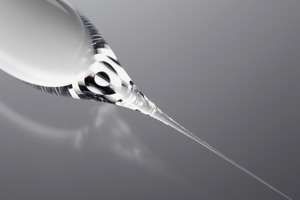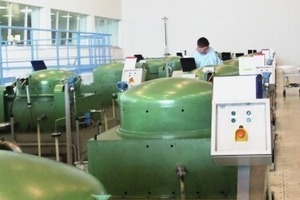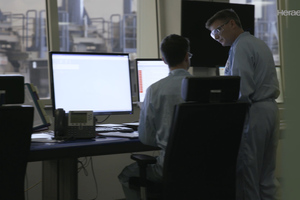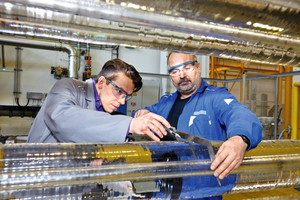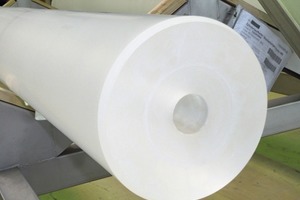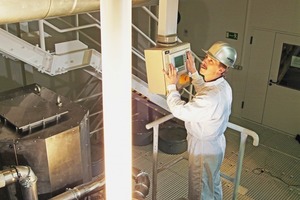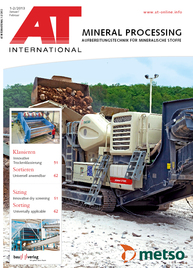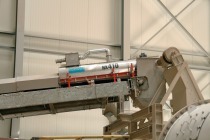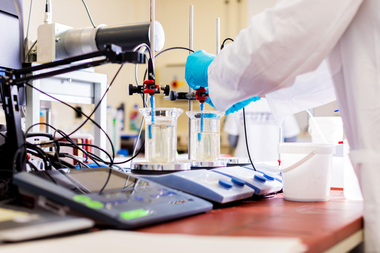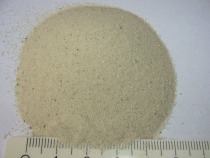Heraeus Quarzglas in Bitterfeld – a success story
On 18.12.1991 Heraeus started the mass production of hollow cylinders from synthetic quartz glass, an important pre-cursor product for the production of glass fibres, at the chemical industry park in Bitterfeld-Wolfen. Following the fall of the Berlin Wall, the industrial area centring around Bitterfeld in Saxony-Anhalt became one of the industrial “building sites” in unified Germany. As a result of the numerous bankruptcies and the now only too visible environmental damage, the huge chemicals region had to reinvent itself. The Bitterfeld model for entrepreneurial cooperation was aimed at creating the right conditions to attract investors to the new chemical industry park. “One of the first investors was Heraeus, and over 20 years ago the foundation stone was laid for a plant for the production of synthetic quartz glass,” explains Christian Nasarow (Fig. 1), plant manager for Heraeus Quarzglas in Bitterfeld. “Following the start-up phase in 1992, with just a handful of employees, we made the first soot bodies, before the mass production of hollow cylinders followed later (Fig. 2),” continues Nasarow.
In addition to the 20-year production anniversary, Heraeus Quarzglas also celebrated its centenary in 2012. On 3 April 1912, Heraeus Quarzglas GmbH was established and registered at Hanau District Court. The first German quartz fusing operation was based in Griesheim near Frankfurt. The oxygen and hydrogen required to melt the glass could be obtained direct from the Griesheim-Elektron company. Founding the new enterprise was Heraeus’ response to the rising demand for quartz glass and its products and brought together innovative technologies. Today the company operates at locations around the world – in Germany (Hanau, Kleinostheim, Bitterfeld), the USA (Austin, Buford, Wilmington), China (Shenyang) and England (Wallsend) – and has over 1400 employees. Heraeus is one of very few specialists with expertise in this material, providing a level of quality in its standard production processes that is unique the world over.
Heraeus Quarzglas GmbH first produced laboratory equipment made of quartz glass for the chemical industry. This was followed by other uses, such as optics (optical quartz glass), temperature measurement (platinum resistance thermometer), and lamps (such as the original Hanau Höhensonne® sun lamp). Thanks to its high quality, over the course of the 1950s, optical quartz glass from Heraeus conquered challenging new areas of application in the fields of astrophysics, aerospace engineering, microelectronics, optical telecommunications, and the semiconductor industry. In 1955, the company produced synthetic fused silica for the first time. Using special blowpipe technology, ultrapure quartz glass with a high degree of UV transparency was produced. Under the brand name Suprasil®, it was embraced by aerospace engineering for use as mirror prisms and lens and window material.
Today, high-purity silica glass is indispensable for the production of microchips and solar cells.Without quartz glass, there would be no internet. It is the key to the information age. Optical fibres (Fig. 3) as thin as a hair transmit huge amounts of data quickly and securely over continents and under oceans. Heraeus manufactures synthetic quartz glass tubes and cylinders, which have been used to produce more than 500 mio. kilometres of glass fibre for optical data transmission technology to date. The quartz glass for these technological lifelines are manufactured and processed at locations in Buford/USA and Bitterfeld/Germany.
Bitterfeld was already known as a chemicals centre back in the 19th century, the main basis for this being the opencast lignite mining that had been started there. At the turn of the century Bitterfeld became the most important centre for chlorine chemistry thanks to the establishment of electrochemical plants. The end of the GDR in 1990 was followed by widespread closure of the industrial operations and the lignite mining. But with the founding of new companies and the new sites for the subsidiaries of well-known chemical groups, the tradition could be carried on. For Heraeus, the factors in favour of Bitterfeld were specifically the good possibilities for the expansion of the production and administration facilities, a location advantage as a result of the long-established chlorine chemistry (chemical network of different companies with an extensive pipeline system), the local availability of highly qualified workforce, and particularly the very good transport links.
Over the years the number of employees at the plant increased, along with the size, weight, and quality of the silica bodies manufactured there. Today Heraeus is technology and global market leader for synthetic quartz glass for applications in the telecommunications industry. On an area of 40 000 m2 at the Bitterfeld site, around 400 employees produce and develop synthetic quartz glass for optical tele-communications. The high-purity SiO2 is produced from silicon tetrachloride in an oxyhydrogen flame. The SiO2 particles are deposited on a target (Figs. 4 and 5), which is then dried. The porous, milky soot bodies are transformed in a zone melting process under vacuum at 1600 to 1700 °C to a solid quartz cylinder that is as clear as glass. To give the quartz bodies the required geometric dimensions for the downstream process, they are then ground to form rotation-symmetric bodies (Figs. 6 and 7). From these, the preforms are produced later in the RIC (Rod-in-Cylinder) process at Buford/USA or the Fibres are directly produced at the customer (Fig. 8).
From three-metre-long cylinders, up to 7000 kilometres of glass fibre can be drawn in one piece. “Currently, an estimated three kilometres of glass fibre per second is produced from our quartz glass,” explains Christian Nasarow. To this day the company has produced synthetic quartz glass cylinders used for the production of over 500 million kilometres of glass fibres for telecommunications. This roughly corresponds to three and a half time the distance from the Earth to the sun or more than 12 000 times the circumference of the Earth. Since commissioning, over 18 000 t synthetic glass has been produced. As Plants I and II are based on a modular design, the plants can be started up or shut down depending on capacity utilization.
The quartz glass experts are also proud of the fact that Heraeus is one of the few companies immortalized on the moon. In addition to putting the first man on the moon on 20 July 1969, the legendary Apollo 11 mission also carried a laser reflector to Earth’s natural satellite. Still in operation today, the reflector is used to measure the exact distance between the Earth and the moon (about 384 000 km). It consists of an array of 100 triple prisms made of quartz glass from Heraeus.

